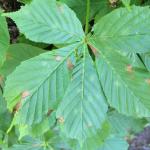Guignardia Leaf Blotch
Pathogen
The fungal pathogen Guignardia aesculi is responsible for Guignardia leaf blotch (Sinclair and Lyon 2005).
Hosts
Guignardia leaf blotch infects many different Aesculus species throughout North America, Europe and Asia (Sinclair and Lyon 2005). In southern New England, horsechestnut (A. hippocastanum) is the most common host. While non-native, horsechestnut has been widely planted in urban and suburban landscapes. Less common ornamental species of Aesculus in New England are also susceptible, and include: bottlebrush buckeye (A. parviflora), Ohio buckeye (A. glabra), painted buckeye (A. sylvatica) and red buckeye (A. pavia).
Symptoms & Signs
Guignardia aesculi produces irregularly-shaped spots and blotches on the foliage of horsechestnuts growing in almost any setting throughout southern New England. The disease is so common on this host that its occurrence is axiomatic. When trees are flowering in spring, the disease is just beginning to establish for the season. Shortly after bloom, water-soaked, pale green lesions begin to develop across the leaf surface. During this early stage of the disease, the blotches may be undetecable without close examination. As the lesions expand, they become dry and turn orange-brown in color. When abundant on the margins, the foliage can curl and wrinkle, becoming generally distorted for the remainder of the growing season. In contrast to foliar blights, foliar blotches attain a certain size and stop developing. Therefore, the foliage is retained for the duration of the growing season. When wet weather is abundant in late spring and early summer, disease severity intensifies. During these years, the foliage appears scorched or burned late in the summer. Aside from growth losses due to unrealized photosynthetic capacity, the disease seems to have only limited impact on otherwise healthy trees. Upon close inspection, black-colored dots may be observed within the blotches. These represent the spore-bearing structures of the fungus. The fruiting bodies of Guignardia overwinter within infected leaves and release spores in the spring to initiate new infections. During wet weather, the spores germinate and infect the leaves of susceptible trees. Over the course of the growing season, the pathogen can continue to sporulate and create new blotches.
Management
Collect and remove discarded leaves to reduce the overwintering inoculum that initiates new infections the following spring. Prune interior canopy branches to increase air circulation and promote sunlight penetration through the canopy in an attempt to minimize periods of leaf wetness. Severe blotching does not develop until later in the growing season, after the majority of annual growth has occurred. Therefore, Guignardia leaf blotch has a relatively limited impact on the overall health of vigorous trees. Fungicide application (mancozeb and copper hydroxide) can help to improve the appearance of specimen trees and nursery stock, but for many mature trees is not practical. Applications should take place as buds open to protect newly developing leaves from primary infections. If adequate prevention of the primary infection is achieved in early spring, then repeated additional treatments may not be necessary to control the secondary infection cycles, unless there are extended periods of mild and wet weather in early summer. Even with fungicide treatment, the disease is likely to occur, illustrating the pervasive nature of the pathogen.
Citation
Sinclair WA and Lyon HH. 2005. Diseases of Trees and Shrubs, 2nd edn. Cornell University Press, Ithaca, NY.



